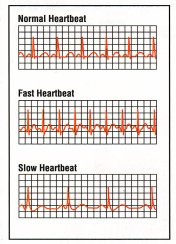Big C Discount Drugs Health Information
Electrocardiogram (EKG or ECG)
EKG Measures the Heart's Rate and Rhythm

An electrocardiogram (abbreviated as an EKG or ECG) is a simple, painless test that shows bean rate and rhythm by recording the electrical activity of the heart. It is often done as part of an annual physical examination. An EKG can also help diagnose heart-related problems in patients who see a doctor because they are experiencing chest pain, dizziness or "skipped" heartbeats. The EKG is actually a "picture" of the electrical impulses that travel through the heart. In addition to revealing a heart that has a fast or slow beat,
an EKG can be used to uncover a wide variety of heart conditions, including abnormal heart rhythms, a heart attack, or an enlarged area of the heart. The test from start to finish takes only a few minutes. The EKG is performed by placing 10 to 15 electrode pads on the skin in various locations on the chest, arms, and legs. The electricity of the heart is then measured while the patient is lying down (known as a "resting EKG"). EKG tests can also be done while a patient is exercising on a treadmill or similar device; this test is called a stress test.
 The electrocardiograph records changing electrical patterns while the heart beats, it is used to diagnose abnormalities in heart action and can reveal significant coronary artery disease.
The electrocardiograph records changing electrical patterns while the heart beats, it is used to diagnose abnormalities in heart action and can reveal significant coronary artery disease.
Electrical Impulses Produce Tracings: An EKG is typically performed by a trained technician. The technician will use adhesive patches to place 10 to 15 electrodes on the chest around the heart, and on the arms and legs. Since the electrodes are attached using adhesives, the area of skin used to attach the electrode is cleaned and shaved, if necessary. A machine records the electrical impulses from the heart for several seconds and by using a pen and special graph paper is able to produce a "tracing." These tracings (above) show variations in heart rates.
Detecting Cardiac Problems: Once the EKG is completed, a doctor reads the tracing and compares it to the pattern of a healthy heart. There are many heart conditions that can be detected by an EKG reading. Some of these conditions include:
Abnormal EKG: If the EKG is abnormal, the doctor can make a decision about what further testing is needed to diagnose the heart condition. Many times, this means further tests such as an EKG stress test, an echocardiogram, or a cardiac catheterization. Some heart rhythm abnormalities are not constant, so they may not be seen while the EKG is taken. In these cases, an ambulatory heart monitor (worn for 24 hours or more) can record the rhythm disturbances and help make the diagnosis. Like many medical tests, EKGs may have false positives or false negatives. This means that the EKG may show an abnormality, called a "false" positive, that turns out to be unimportant; a "false" negative may be an EKG tracing that misses the early stages of coronary heart disease or other heart conditions.


 The electrocardiograph records changing electrical patterns while the heart beats, it is used to diagnose abnormalities in heart action and can reveal significant coronary artery disease.
The electrocardiograph records changing electrical patterns while the heart beats, it is used to diagnose abnormalities in heart action and can reveal significant coronary artery disease.EKG Can Reveal Cardiac Problems
An electrocardiogram is commonly performed because it is safe, readily available, simple to perform, and inexpensive. It is a useful test because it can reveal many heart conditions that would otherwise go undiagnosed. It can also help in the diagnosis of heart problems that cause symptoms, such as chest pain and dizziness, that will prompt a patient to see a doctor for evaluation. EKGs are even used to monitor the effect of heart medications.Electrical Impulses Produce Tracings: An EKG is typically performed by a trained technician. The technician will use adhesive patches to place 10 to 15 electrodes on the chest around the heart, and on the arms and legs. Since the electrodes are attached using adhesives, the area of skin used to attach the electrode is cleaned and shaved, if necessary. A machine records the electrical impulses from the heart for several seconds and by using a pen and special graph paper is able to produce a "tracing." These tracings (above) show variations in heart rates.
Detecting Cardiac Problems: Once the EKG is completed, a doctor reads the tracing and compares it to the pattern of a healthy heart. There are many heart conditions that can be detected by an EKG reading. Some of these conditions include:
- a heart defect from birth
- disease of the heart valves or muscle
- an enlarged heart chamber
- coronary artery disease (atherosclerosis)
- arrhythmias, including fast or slow heartbeats or irregular beats
- a new heart attack, or damage from a previous heart attack
- endocarditis, an inflammation of the heart lining
- change in electrolytes in the body, such as sodium or potassium
Abnormal EKG: If the EKG is abnormal, the doctor can make a decision about what further testing is needed to diagnose the heart condition. Many times, this means further tests such as an EKG stress test, an echocardiogram, or a cardiac catheterization. Some heart rhythm abnormalities are not constant, so they may not be seen while the EKG is taken. In these cases, an ambulatory heart monitor (worn for 24 hours or more) can record the rhythm disturbances and help make the diagnosis. Like many medical tests, EKGs may have false positives or false negatives. This means that the EKG may show an abnormality, called a "false" positive, that turns out to be unimportant; a "false" negative may be an EKG tracing that misses the early stages of coronary heart disease or other heart conditions.
